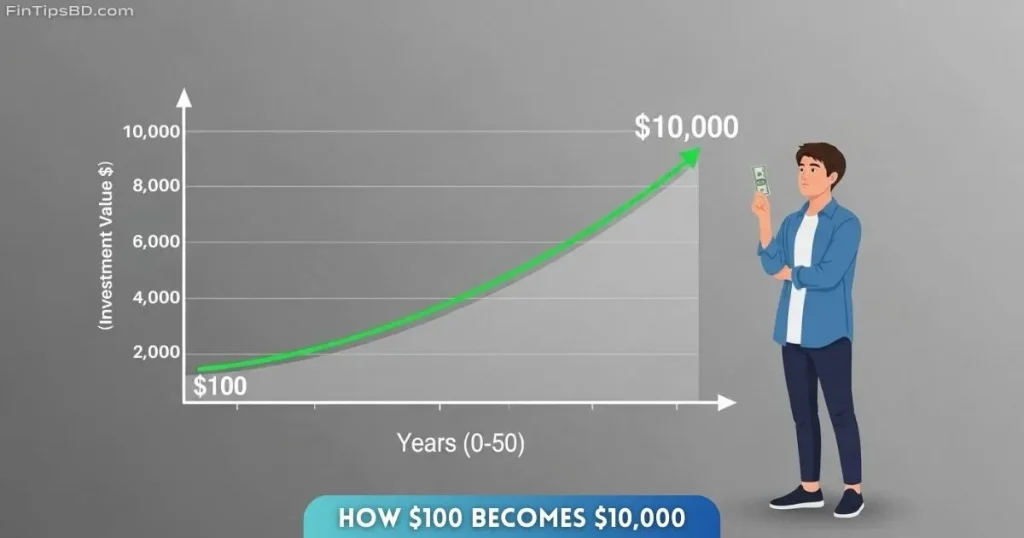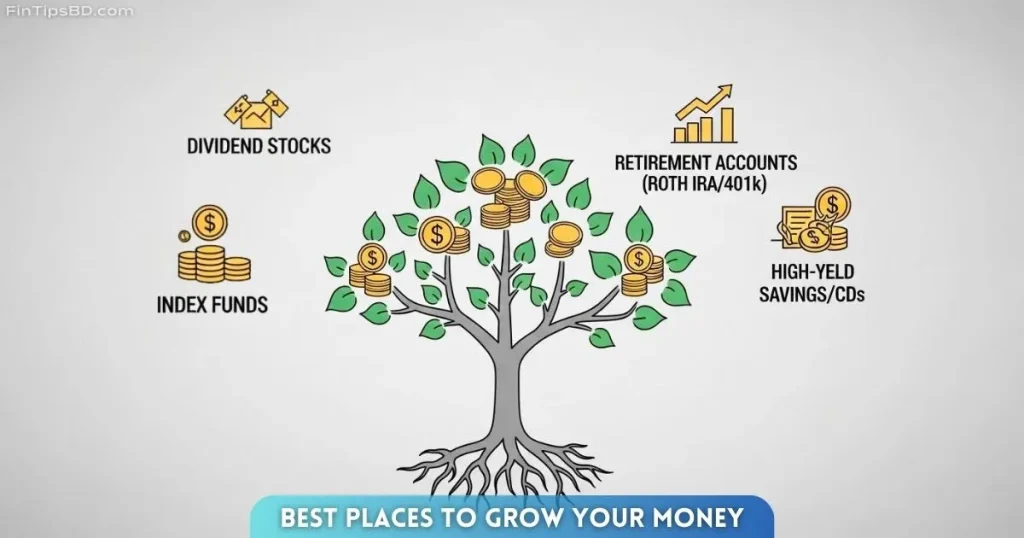This Compound Interest Trick Turns $100 Into $10,000 (Most People Ignore It)

Plenty of people daydream about getting rich overnight, but let’s be honest — real wealth usually doesn’t come from lucky breaks. Most of the time, it’s built slowly, quietly, thanks to something most folks overlook: compound interest. It’s not some hidden hack — it’s a straightforward but seriously underrated principle that can turn even a small amount like $100 into something much more meaningful over time. Let’s break down how compound interest works, why it’s often ignored, and how you can start using it to your benefit.
Table Of Contents
What Compound Interest Really Is (And Why It’s a Big Deal)
In simple terms, compound interest means you earn interest not only on your original deposit but also on the interest you’ve already earned. That’s the real power: your money doesn’t just grow — it starts growing on top of its own growth. Over time, this creates a compounding loop that speeds things up more than you’d expect.
Now compare this to simple interest, where your earnings are based only on the starting amount. With compound interest, your money acts like a snowball rolling downhill — it keeps picking up speed the longer it goes. Say you invest $100 at a 10% annual compound interest rate. After one year, you’d have $110. The next year, that 10% applies to the whole $110, not just your initial $100. And that’s when growth really starts to kick in.
See It In Action: How $100 Can Become $10,000 (Or More)

To really understand the power of compound interest, let’s use real numbers.
No Extra Contributions
- Starting amount: $100
- Yearly return: 10%
- Time: 50 years
Using a standard compound interest calculator, that original $100 could grow into around $11,739 in five decades. That’s more than 100 times what you started with — all without adding more money, gambling on risky investments, or doing anything complicated. Just patience and steady returns. This is the textbook definition of long-term investing that works.
The Rule of 72: A Shortcut for Estimating Growth
Wondering how long it takes for your money to double? The rule of 72 formula gives a quick estimate. Just divide 72 by your interest rate, and you’ll get a rough idea of how many years it’ll take.
If you’re earning 10%:
72 ÷ 10 = 7.2 years
So here’s what that looks like:
- Year 0: $100
- Year 7.2: $200
- Year 14.4: $400
- Year 21.6: $800
And so on.
Each doubling gets more dramatic. This is how compound interest works — by snowballing your gains over time into something much bigger than you’d expect.
Time Is the Real Superpower
Lots of people think you need a big lump sum to grow real wealth. Sure, a larger starting amount helps — but if you want to unlock the true power of compound interest, time is your best friend.
Even if you only start investing with $100, what matters more is starting early and letting time do its thing. Small, regular investments can turn into something impressive if you’re consistent and patient. On the flip side, waiting even a few years to start can seriously shrink your future gains.
Here’s an example:
If you invest $100 at 10% annual return:
- Start at age 20 → Grows to about $11,739 by age 70
- Start at age 30 → Only worth around $4,526 by age 70
Same amount invested. The only difference? You started later. That 10-year delay cost you more than $7,000. It’s a sharp reminder that when it comes to long-term investing tips, timing really is everything.
Want to Grow Your Money Faster? Add to It Regularly
The idea of just letting one deposit sit and grow is great, but if you really want to grow your money faster, start adding to it every month. Even small, steady contributions can speed up compounding in a big way.
Let’s say you start with $100 and add $20 every month:
- Annual return: 10%
- Timeframe: 30 years
At the end of those 30 years, you’d have around $41,000 or more. There’s no trick — this is simply what happens when you keep investing and let the numbers do their job. And if you bump your monthly deposit up to $50? The total climbs even faster.
The takeaway: regular investing multiplies your results. This is why consistent contributions are a key part of any solid compound interest strategy — not just tossing in money once and forgetting about it.
Best Places to Put Your Money for Compound Growth

Now that you know how the math works, let’s talk about where to actually put your money to take advantage of compound interest. Here are a few solid options:
1. Index Funds (like S&P 500 trackers)
These funds aim to mirror the performance of big stock market indexes. They’re diversified, often low-cost, and historically give returns of 8–10% annually. Many let you reinvest dividends automatically through something called a DRIP (Dividend Reinvestment Plan), which boosts your compounding even more. For most people, these are among the best compound interest investments out there.
2. Dividend-Paying Stocks
Companies that pay regular dividends can offer steady income. Reinvesting those dividends buys you more shares, which means your future dividends get larger too — it’s like compounding in action. This can help build a long-term passive income stream.
3. Retirement Accounts (Roth IRA, 401(k))
These accounts come with tax advantages — either tax-free growth or tax-deferred contributions. That means more of your money stays invested and keeps compounding. They’re ideal for long-term goals like retirement.
4. High-Yield Savings or CDs
These won’t grow as fast as stocks, but they offer safe, guaranteed interest. They’re great for short-term goals or emergency funds where you still want compound interest working in the background.
Just remember: higher returns usually mean higher risk. That’s why spreading your money across different kinds of investments — known as diversification — is one of the smartest moves you can make. It helps manage risk and smooth out returns, especially if you’re following a beginner investing guide.
Watch Out: Mistakes That Ruin Compounding
Even if you understand how this all works, some common slip-ups can seriously weaken your results. Here are a few to avoid:
- Pulling money out early: Every time you withdraw funds, you cut off future gains that would’ve grown from those dollars.
- Skipping regular deposits: It’s not about how much you put in at once — it’s about showing up consistently. Missing contributions can throw off your whole plan.
- Overlooking fees: Hidden costs like management fees, transaction charges, or expensive mutual fund fees can quietly drain your growth. Always know what you’re paying.
- Chasing hype: Don’t fall for the hot stock or trendy investment of the week. Real wealth from compound interest comes from steady, reliable investing — not trying to guess the next big thing.
Don’t Underestimate Small Beginnings
One of the biggest mental blocks people have is thinking, “It’s just $100 — that won’t matter.” But here’s the thing: that mindset is exactly what stops people from building wealth.
A hundred dollars might not seem like much, but it’s enough to kickstart the compounding process. And once that momentum starts, it builds — slowly at first, then much faster. Compound interest doesn’t care how small you start; it rewards time and consistency.
Even some of the wealthiest investors — like Warren Buffett — made most of their fortunes later in life. Not because they changed what they were doing, but because compound interest had decades to work. His wealth snowballed thanks to time and steady investing, not flashy bets.
At the end of the day, the biggest difference between people who build serious wealth and those who don’t often comes down to one simple choice: they decided to start.
How to Start Investing With Just $100
If you’re ready to stop waiting and let compound interest work for you, here’s a simple way to get going today:
1. Open an account
You can use a trusted online brokerage, a robo-advisor that manages things for you automatically, or even your existing bank. The process usually takes just a few minutes.
2. Choose a long-term fund
Look for a solid index fund or ETF (Exchange Traded Fund) with a track record of steady returns. These are great for beginners and align well with most long-term investing tips.
3. Set up automatic investments
Even $10 or $20 a month is enough to build momentum. Automation makes it easy to stay consistent — and that consistency is what powers compounding.
4. Check your progress occasionally
Using a compound interest calculator every few months can help you stay motivated. Watching your money grow, even slowly, reinforces the habit.
5. Be patient
The truth is, compound interest doesn’t create big results overnight. It takes years. But if you stick with it, the results will come — and they’ll be worth it.
This isn’t a shortcut to fast riches. It’s a proven, reliable way to build wealth slowly — but surely.
Final Thought: Time Is the Game-Changer
Compound interest isn’t flashy. It doesn’t make headlines. But it’s one of the most powerful tools in personal finance — and anyone can use it.
Start investing with $100. Add to it regularly. Be patient, stay consistent. One day, that decision — the one that felt small at the time — could be the reason you’re financially free.
Disclaimer : This article is for educational purposes only and does not constitute financial advice. Always consult with a licensed financial advisor before making investment decisions. Past performance is not a guarantee of future results. Investing involves risk, including the potential loss of principal.
